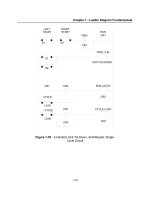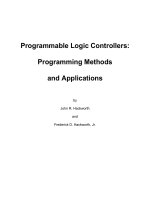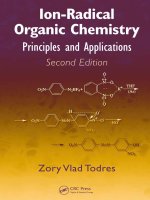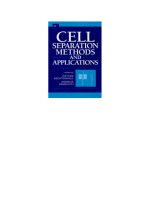Analytical chemistry methods and applications
Bạn đang xem bản rút gọn của tài liệu. Xem và tải ngay bản đầy đủ của tài liệu tại đây (5.55 MB, 362 trang )
Trimm
Analytical Chemistry
Methods and Applications
Analytical Chemistry
Analytical chemistry is the study of what chemicals are present and in what amount in natural and
artificial materials. Because these understandings are fundamental in just about every chemical
inquiry, analytical chemistry is used to obtain information, ensure safety, and solve problems in
many different chemical areas, and is essential in both theoretical and applied chemistry.
Analytical chemistry is driven by new and improved instrumentation. This collection presents a
broad selection of articles on analytical chemistry, including methods of determination and
analysis as applied to pharmaceuticals, foods, proteins, and more.
Methods and Applications
Other Titles in the Series
• Organic Chemistry: Structure and Mechanisms
• Inorganic Chemistry: Reactions, Structure and Mechanisms
• Physical Chemistry: Chemical Kinetics and Reaction Mechanisms
Related Titles of Interest
• Environmental Chemistry: New Techniques and Data
• Industrial Chemistry: New Applications, Processes and Systems
• Recent Advances in Biochemistry
Methods and Applications
He received his PhD in chemistry, with a minor in biology, from Clarkson University in 1981 for his
work on fast reaction kinetics of biologically important molecules. He then went on to Brunel
University in England for a postdoctoral research fellowship in biophysics, where he studied the
molecules involved with arthritis by electroptics. He recently authored a textbook on forensic
science titled Forensics the Easy Way (2005).
Analytical Chemistry
About the Editor
Dr. Harold H. Trimm was born in 1955 in Brooklyn, New York. Dr. Trimm is the chairman of the
Chemistry Department at Broome Community College in Binghamton, New York. In addition, he is
an Adjunct Analytical Professor, Binghamton University, State University of New York,
Binghamton, New York.
ISBN 978-1-926692-58-6
Harold H. Trimm, PhD
00000
Apple Academic Press
www.appleacademicpress.com
9 781926 692586
Research Progress in Chemistry
Apple
Academic
Press
Editor
Analytical Chemistry
Methods and Applications
This page intentionally left blank
Research Progress in Chemistry
Analytical Chemistry
Methods and Applications
Harold H. Trimm, PhD, RSO
Chairman, Chemistry Department, Broome Community College;
Adjunct Analytical Professor, Binghamton University,
Binghamton, New York, U.S.A.
Apple Academic Press
CRC Press
Taylor & Francis Group
6000 Broken Sound Parkway NW, Suite 300
Boca Raton, FL 33487-2742
Apple Academic Press, Inc
3333 Mistwell Crescent
Oakville, ON L6L 0A2
Canada
© 2011 by Apple Academic Press, Inc.
Exclusive worldwide distribution by CRC Press an imprint of Taylor & Francis Group, an Informa
business
No claim to original U.S. Government works
Version Date: 20120813
International Standard Book Number-13: 978-1-4665-5976-9 (eBook - PDF)
This book contains information obtained from authentic and highly regarded sources. Reasonable
efforts have been made to publish reliable data and information, but the author and publisher cannot
assume responsibility for the validity of all materials or the consequences of their use. The authors and
publishers have attempted to trace the copyright holders of all material reproduced in this publication
and apologize to copyright holders if permission to publish in this form has not been obtained. If any
copyright material has not been acknowledged please write and let us know so we may rectify in any
future reprint.
Except as permitted under U.S. Copyright Law, no part of this book may be reprinted, reproduced,
transmitted, or utilized in any form by any electronic, mechanical, or other means, now known or
hereafter invented, including photocopying, microfilming, and recording, or in any information storage or retrieval system, without written permission from the publishers.
For permission to photocopy or use material electronically from this work, please access www.copyright.com ( or contact the Copyright Clearance Center, Inc. (CCC), 222
Rosewood Drive, Danvers, MA 01923, 978-750-8400. CCC is a not-for-profit organization that provides licenses and registration for a variety of users. For organizations that have been granted a photocopy license by the CCC, a separate system of payment has been arranged.
Trademark Notice: Product or corporate names may be trademarks or registered trademarks, and are
used only for identification and explanation without intent to infringe.
Visit the Taylor & Francis Web site at
and the CRC Press Web site at
For information about Apple Academic Press product
Contents
Introduction9
1. Micelle Enhanced Fluorimetric and Thin Layer Chromatography
Densitometric Methods for the Determination of (±) Citalopram
and its S – Enantiomer Escitalopram
Elham A. Taha, Nahla N. Salama and Shudong Wang
2. A Multidisciplinary Investigation to Determine the Structure
and Source of Dimeric Impurities in AMG 517 Drug Substance
46
Ashraf M. Mahmoud, Nasr Y. Khalil, Ibrahim A. Darwish and
Tarek Aboul-Fadl
4. Analytical Applications of Reactions of Iron(III) and
Hexacyanoferrate(III) with 2,10-Disubstituted Phenothiazines
26
Maria Victoria Silva Elipe, Zhixin Jessica Tan, Michael Ronk and
Tracy Bostick
3. Selective Spectrophotometric and Spectrofluorometric Methods
for the Determination of Amantadine Hydrochloride in Capsules and
Plasma via Derivatization with 1,2-Naphthoquinone-4-sulphonate
11
Helena Puzanowska-Tarasiewicz, Joanna Karpińska and
Ludmiła Kuźmicka
63
6 Analytical Chemistry: Methods and Applications
5. Quantitative Mass Spectrometric Analysis of Ropivacaine and
Bupivacaine in Authentic, Pharmaceutical and Spiked Human Plasma
without Chromatographic Separation
Nahla N. Salama and Shudong Wang
6. Kinetic Spectrophotometric Determination of Certain
Cephalosporins in Pharmaceutical Formulations
218
Helena Gonzalez, Carl-Eric Jacobson, Ann-Marie Wennberg,
Olle Larkö and Anne Farbrot
12. A Simple and Selective Spectrophotometric Method for the
Determination of Trace Gold in Real, Environmental, Biological,
Geological and Soil Samples Using Bis(Salicylaldehyde)
Orthophenylenediamine
191
Mark D. Robinson, David P. De Souza, Woon Wai Keen,
Eleanor C. Saunders, Malcolm J. McConville, Terence P. Speed
and Vladimir A. Likić
11. Solid-Phase Extraction and Reverse-Phase HPLC: Application
to Study the Urinary Excretion Pattern of Benzophenone-3 and
its Metabolite 2,4-Dihydroxybenzophenone in Human Urine
164
Tadashi Yoshida, Akira Honda, Hiroshi Miyazaki and
Yasushi Matsuzaki
10. A Dynamic Programming Approach for the Alignment of
Signal Peaks in Multiple Gas Chromatography-Mass Spectrometry
Experiments
136
Bryan A. P. Roxas and Qingbo Li
9. Determination of Key Intermediates in Cholesterol and
Bile Acid Biosynthesis by Stable Isotope Dilution Mass
Spectrometry
114
John Geraldine Sandana Mala and Satoru Takeuchi
8. Significance Analysis of Microarray for Relative Quantitation
of LC/MS Data in Proteomics
92
Mahmoud A. Omar, Osama H. Abdelmageed and Tamer Z. Attia
7. Understanding Structural Features of Microbial Lipases—
An Overview
78
Rubina Soomro, M. Jamaluddin Ahmed, Najma Memon and
Humaira Khan
231
Contents 7
13. Palm-Based Standard Reference Materials for Iodine Value
and Slip Melting Point
Azmil Haizam Ahmad Tarmizi, Siew Wai Lin and Ainie Kuntom
14. Biomedical and Forensic Applications of Combined Catalytic
Hydrogenation-Stable Isotope Ratio Analysis
327
Hassan Arida, Mona Ahmed and Abdallah Ali
19. GC-MS Studies of the Chemical Composition of Two Inedible
Mushrooms of the Genus Agaricus
307
Chiara Borromei, Maria Careri, Antonella Cavazza, Claudio Corradini,
Lisa Elviri, Alessandro Mangia and Cristiana Merusi
18. Preparation, Characterization, and Analytical Application
of Ramipril Membrane-Based Ion-Selective Electrode
289
Misaki Wayengera
17. Evaluation of Fructooligosaccharides and Inulins as Potentially
Health Benefiting Food Ingredients by HPAEC-PED and
MALDI-TOF MS
278
Cheng Bai, Charles C. Reilly and Bruce W. Wood
16. Searching for New Clues about the Molecular Cause of
Endomyocardial Fibrosis by Way of In Silico Proteomics and
Analytical Chemistry
266
Mark A. Sephton, Will Meredith, Cheng-Gong Sun and Colin E. Snape
15. Identification and Quantitation of Asparagine and Citrulline
Using High-Performance Liquid Chromatography (HPLC)
255
339
Assya Petrova, Kalina Alipieva, Emanuela Kostadinova, Daniela Antonova,
Maria Lacheva, Melania Gjosheva, Simeon Popov and Vassya Bankova
20. Structural Analysis of Three Novel Trisaccharides Isolated from
the Fermented Beverage of Plant Extracts
347
Hideki Okada, Eri Fukushi, Akira Yamamori, Naoki Kawazoe,
Shuichi Onodera, Jun Kawabata and Norio Shiomi
Index362
This page intentionally left blank
Introduction
Chemistry is the science that studies atoms and molecules along with their properties. All matter is composed of atoms and molecules, so chemistry is all encompassing and is referred to as the central science because all other scientific fields
use its discoveries. Since the science of chemistry is so broad, it is normally broken
into fields or branches of specialization. The five main branches of chemistry are
analytical, inorganic, organic, physical, and biochemistry. Chemistry is an experimental science that is constantly being advanced by new discoveries. It is the
intent of this collection to present the reader with a broad spectrum of articles in
the various branches of chemistry that demonstrates key developments in these
rapidly changing fields.
Analytical chemistry is the study of which chemicals are present and in what
amount. This often involves trying to determine trace amounts of one chemical
in a complicated matrix of other chemicals. Analytical chemistry is driven by new
and improved instrumentation. Advances in mass spectrometry, chromatography,
electrophoresis, electrochemistry, biosensors, and other instruments are allowing
analytical chemists to measure smaller and smaller concentrations of chemicals
in complex mixtures. This has direct application to the fields of environmental
science, medicine, forensics, food safety, and engineering. The determination of
STRs in DNA by capillary electrophoresis, fluorescent dyes, and lasers has led to
a revolution in criminal investigation and identification in the field of forensics.
Present guidelines for the concentration of chemicals in the air we breathe and
10 Analytical Chemistry: Methods and Applications
water we drink are based on the detection limits that analytical chemists can
achieve.
Chapters within this book ensure that the analytical chemist can stay current
with the latest methods and applications in this important field.
— Harold H. Trimm, PhD, RSO
Micelle Enhanced
Fluorimetric and Thin
Layer Chromatography
Densitometric Methods
for the Determination of
(±) Citalopram and its S –
Enantiomer Escitalopram
Elham A. Taha, Nahla N. Salama and Shudong Wang
Abstract
Two sensitive and validated methods were developed for determination of
a racemic mixture citalopram and its enantiomer S-(+) escitalopram. The
first method was based on direct measurement of the intrinsic fluorescence of
12 Analytical Chemistry: Methods and Applications
escitalopram using sodium dodecyl sulfate as micelle enhancer. This was further applied to determine escitalopram in spiked human plasma, as well as in
the presence of common and co-administerated drugs. The second method was
TLC densitometric based on various chiral selectors was investigated. The optimum TLC conditions were found to be sensitive and selective for identification and quantitative determination of enantiomeric purity of escitalopram
in drug substance and drug products. The method can be useful to investigate
adulteration of pure isomer with the cheap racemic form.
Keywords: citalopram, escitalopram, micelle fluorimetry, spiked plasma, thin
layer chromatography densitometry, chiral selectors
Introduction
Citalopram (Fig. 1) a selective serotonine re-uptake inhibitor (SSRI), has been
used for the treatment of depression, social anxiety disorder, panic disorder and
obsessive-compulsive disorder.1–3 Citalopram is sold as a racemic mixture, consisting of 50% R-(−)-citalopram and 50% S-(+)-citalopram. As the S-(+) enantiomer
has the desired antidepressant effect4 it is now marketed under the generic name
of escitalopram. It has been shown that the R-enantiomer present in citalopram
counteracts the activity of escitalopram. Citalopram and escitalopram have demonstrated different pharmacological and clinical effects.5
A number of techniques including spectrophotometric,6,7 fluorimetric,8,9
electrochemical,10 chromatography11,12 and capillary electrophoresis13,14
have been developed for the determination of enantiomeric citalopram. Although
several chiral methods including LC15–20 and CE21,22 are available for separation of racemic citalopram, there is no report concerning enantiomeric separation
of citalopram using thin layer chromatography (TLC).
In this study we develop two simple, economic and validated methods for determination of escitalopram and enantioseparation of its racemic mixture in drug
substance and drug products. The fluorimetric method was based on the fluorescence spectral behavior of escitalopram in micellar systems, such as Triton® X-100,
Cetylpyridinium bromide; and sodium dodecyl sulfate (SDS). The fluorescence
intensity of escitalopram and its racemic mixture citalopram was compared under
the same experimental conditions. The method was successfully applied to the
analysis of escitalopram in drug substances, drug product as well as spiked human
plasma. Furthermore, the method was found to tolerate high concentrations of
co-administrated and common drugs without potential interference. In addition
to the fluorimetric method, TLC densitometry was proposed for stereoselective
Micelle Enhanced Fluorimetric and Thin Layer Chromatography 13
separation of (±) citalopram and determination of its enantiomer, escitalopram,
using the different chiral selectors namely, brucine sulphate, chondroitin sulphate,
heparin sodium and hydroxypropyl-β-cyclodextrin (HP-β-CD). The developed
TLC method based on chiral mobile phase additives (CMPAs), tend to be cheap
and feasible and offer a potential strategy for simultaneous separation of different chiral drugs on the same plate. The method was validated according to ICH
guidelines and can become the method of choice compared to other techniques
for fast routine enantiomeric analysis.
Experimental
Instrumentation
Waters-2525 LC system, equipped with a dual wavelength absorbance detector
2487, an auto-sampler injector and Mass Lynx v 4.1, was used. The LC column was C18 reverse-phase column (4.6 mm diameter × 100 mm length, 5 µm
particles, phenomenex, monolithic).1 H-NMR spectra were recorded on Bruker
Avance-400 spectrometer operating at 400 MHz. FT-IR spectrometer Avatar 360
was used. Spectrofluorimetric measurement was carried out using a Shimadzu
spectrofluorimeter Model RF-1501 equipped with xenon lamp and 1-cm glass
cells. Excitation and emission wavelengths were set at 242 nm and 306 nm respectively. Pre-coated TLC plates (10 × 10 cm, aluminum plate coated with 0.25
mm silica gel F254) were purchased from Merck Co., Egypt. Samples were applied to the TLC plates with 25 µL Hamilton microsyringe. UV short wavelength
lamp (Desaga Germany) and Shimadzu dual wavelength flying spot densitometer,
Model CS-9301, PC were used. The experimental conditions of the measurements were as follows: wavelength = 240 nm, photo mode = reflection, scan mode
= zigzag, and swing width = 10.
Chemicals and Reagents
All chemicals used were of analytical grade if not stated otherwise. Escitalopram
oxalate (Alkan Pharm Co., Egypt) certified to contain 99.60% was used as the
reference standard. Cipralex containing 10 mg escitalopram oxalate per tablet
(manufactured by Lund beck Co., Denmark, Batch No 2147226, Mfg. D: 2008,
Exp. D: 2011) was purchased from the market. Escitalopram oxalate was extracted
and purified from cipralex tablets. Citalopram was kindly supplied by Adwia Co.,
Egypt. Its purity was found to be 99.80% according to official HPLC method.23
Lecital, containing 40 mg citalopram hydrobromide per tablet (manufactured
by Joswe Medical Co., Jordon) was purchased from the market. Human plasma
14 Analytical Chemistry: Methods and Applications
was kindly supplied from Vacsera, Egypt. Sodium dodecyl sulfate (BHD, Egypt),
brucine sulphate (BHD, Egypt), chondroitin sulfate, (Eva Co., Egypt), heparin
sodium and 2-hydroxypropylβ-cyclodextrin (Fluka, Egypt) were purchased. Trifluoroacetic acid (Aldrich, U.K), methanol and acetonitrile (Fisher Scientific,
U.K.) were LC grade. Ultra pure water (ELGA, U.K.) was used.
Figure 1. Chemical structure of citalopram enantiomers.
Extraction of Escitalopram from Cipralex Tablets
Ten cipralex tablets were finely powdered and transferred to a 100 mL conical
flask to which 50 mL methanol was added and stirred for 20 min. The solution
was filtered through whatman No. 42 filter paper. The residue was washed several
times with small volume of methanol for complete recovery. The combined extract was evaporated and the pure sample was obtained by recryslallization from
methanol.
Characterization of Isolated Escitalopram
The weight of escitalopram oxalate obtained by extraction and recrystalization
was the same as the labeled value. Characterization of the extracted escitalopram
was done using UV, TLC, LC-MS and NMR.
Absorbance spectra were recorded in methanol and TLC separation was carried
out using toluene-ethyl acetate-triethylmine (7:3.5:3 v/v/v) as the mobile phase.11
LC-MS was used for establishing the purity of escitalopram using a reverse phase
C18 column at flow rate of 1 ml/min and acetonitrile: water:trifluoroacetic acid
(60:40:0.01% v/v/v) mobile phase. Further characterization included FT-IR, 1HNMR in deuterated methanol (CD3OD).
Micelle Enhanced Fluorimetric and Thin Layer Chromatography 15
Standard Solutions
Standard stock solutions of (±) citalopram hydrobromide, and S-(+) escitalopram
oxalate 0.05 mg mL−1 and 4 mg mL−1 were prepared by dissolving appropriate
amounts of each in water and methanol for fluorimetric and TLC methods respectively. The stock solutions were subsequently used to prepare working standards in methanol. All solutions were stored in refrigerator at 4ºC.
Synthetic Mixtures
For TLC method, synthetic mixtures of escitalopram and citalopram in proportions ranging from 10%–90% were analyzed and the percentage recovery of escitalopram was calculated.
Method Development
Spectrofl Uorimetric Method
1 mL of aqueous stock solution equivalent to (1.25–162.5 µg mL−1) of escitalopram or (1.25–125.0 µg mL−1) citalopram was transferred into a series of 10 mL
volumetric fl asks followed by 1 mL SDS (5 mmol aqueous solution). The volume
was completed to the mark with methanol. The fluorescence was measured at 306
nm using 242 nm as excitation wavelength. To obtain the standard calibration
graph, concentrations were plotted against fluorescence intensity and the linear
regression equations were computed.
TLC Method
Chromatograms were developed in clean, dry, paper-lined glass chambers (12 ×
24 × 24 cm) pre-equilibrated with developer for 10 minutes. The TLC plates
were prepared by running the mobile phase of acetonitrile-water (17:3 v/v) containing 1 mmol chiral selector to the lost front in the usual ascending way and
were air-dried. For detection and quantifi cation, 10 µL each of citalopram and
escitalopram solutions within the quantification range were applied side-by-side
as separate compact spots 20 mm apart and 10 mm from the bottom of the TLC
plates using a 25 µL Hamilton micro syringe. The chromatograms were developed up to 8 cm in the usual ascending way using the same mobile phase omitting
the chiral selectors, and were then air dried. The plates were visualized at 254 nm
or by exposure to I2 vapor and scanned for escitalopram at wavelength 240 nm
using the instrumental parameters mentioned above.
16 Analytical Chemistry: Methods and Applications
For quantitative determination of escitalopram aliquots of standard solution
(4 mg mL−1) equivalent to 0.125–4.000 mg were transferred into 10 mL volumetric flasks and made up to volume with methanol. 10 µL of each concentration
was applied on the TLC plate, air dried and scanned for escitalopram at 240 nm
using the instrumental parameters mentioned above. The average peak areas were
calculated and plotted against concentration. The linear relationship was obtained
and the regression equation was recorded.
Application to Tablets
An accurately weighed amount of powdered tablets equivalent to 100 mg of escitalopram and citalopram were dissolved in 50 mL methanol. The solutions were
stirred with magnetic stirrer for 20 min. Each solution was transferred quantitatively to a 50 mL volumetric flask, diluted to the volume with methanol, and
filtered. For fluorimetric analysis, a portion equivalent to 25 mg was evaporated,
transferred quantitatively to a 50 mL volumetric flask and made up to volume
with water. The procedure was completed as mentioned above.
Application to Spiked Human Plasma
Aliquots equivalent to 0.1–0.4 mg mL−1 of escitalopram were sonicated with 1
mL plasma for 5 minutes. Acetonitrile (2 mL) was added and then centrifuged for
30 minutes. One milliliter of supernatant was evaporated and the procedure was
completed as described above.
Results and Discussion
In this work a simple method was used for isolation of escitalopram from its
drug product rather than the published procedure.24 The isolated escitalopram
was characterized and confirmed by different analytical techniques as mentioned
above.
Fluorimetric Method
Escitalopram solution was found to exhibit an intense fluorescence at a wavelength
of 306 nm on excitation at 242 nm as shown in Figure 2. Different media such
as water, methanol and ethanol were attempted. Maximum fluorescence intensity
was obtained upon using methanol as diluting solvent, while water decreases the
fl uorescence intensity.
The effect of different surfactants on the fluorescence intensity of escitalopram
was studied by adding 1 mL of each surfactant to the aqueous drug solution. CPB
Micelle Enhanced Fluorimetric and Thin Layer Chromatography 17
and Triton X-100 led to peak broadening and no effect on fluorescence intensity,
while SDS caused two fold increasing in the intensity. The fluorescence intensity
was stable for at least two hours.
Figure 2. Fluorescence spectra of 10 µg mL−1 escitalopram oxalate a) in methanolic medium b) in 5 mM SDS
micellar medium c) spiked plasma sample (6.6 µg mL−1) in 5 mM SDS micellar medium d) blank plasma
sample.
When compared to its racemic form, escitalopram showed a lower fluorescence intensity. This is concordance with published data giving the molar absorbitivity of escitalopram as 13.630 mol−1cm−1 while that of citalopram is 15.630
mol−1cm−1.8.
The quantum yield was found to be 0.026 for escitalopram and 0.030 for
citalopram according to the following equation.25
Yu = Ys . Fu/Fs . As/Au
where Yu and Ys referred to fluorescence quantum yield of escitalopram and quinine sulphate, respectively; Fu and Fs represented the integral fluorescence intensity of escitalopram and quinine sulphate, respectively; Au and As referred to
the absorbance of escitalopram and quinine sulphate at the excited wavelength
respectively.
The method was validated by testing linearity, specificity, precision and reproducibility as presented in (Table 1).
18 Analytical Chemistry: Methods and Applications
Table 1. Validation report on the fluorimetric and TLC-densitometric methods for the determination of
escitalopram in drug substance.
Calibration plot was found to hold good over a concentration range of 0.125–
16.25 µg mL−1 and 0.125–12.50 µg mL−1 for escitalopram and citalopram respectively. The procedure gave good reproducibility when applied to escitalopram
drug substance over three concentration levels; 3.30, 6.60 and 13.30 µg mL−1.
Whereas the specificity was proved by quantitate the studied drug in its tablet
form, confirming non-interference from excipients and additives.
The results were comparable to those given by a reported method8 as revealed
by statistical analysis adopting Student’s t- and F-tests, where no significant difference was noticed between the two methods as presented in (Table 2). The validity
of the procedure was further assured by the recovery of the standard addition. The
limit of detection (LOD) and the limit of quantification (LOQ) were found to be
0.017 and 0.056 µgmL−1 respectively.
The high sensitivity attained by the fluorimetric procedure allowed its successful application to the analysis of escitalopram in spiked human plasma. To avoid
variation in background fl uorescence, a simple deproteination of plasma samples
with acetonitrile was performed followed by centrifugation, the clear supernatant
containing escitalopram was analyzed. A calibration graph was obtained by spiking plasma samples with escitalopram in the range 3.30–16.25 µg mL−1. Linear
regression analysis of the data gave the equation
FI = 37.27 C + 126
r = 0.991 (n = 6)
Micelle Enhanced Fluorimetric and Thin Layer Chromatography 19
where FI is the fl uorescence intensity, C is the concentration of escitalopram
in plasma in µg mL−1 and r is correlation coefficient. The limit of detection and
quantification in spiked plasma were found to be 0.17 µg mL−1 and 0.56 µg mL−1.
The average recovery was 98.00% ± 2.80% RSD. The results from analysis of 5
spiked plasma samples are presented in Table 2.
Table 2. Analytical applications of fluorimetric method.
Table 3. Interference study of different compounds in the determination of 5 µg mL−1 of escitalopram by
fluorimetric method.
20 Analytical Chemistry: Methods and Applications
The interference due to co-administrated and common drugs was investigated
in mixed solutions containing 5 µg mL−1 escitalopram and different concentrations of an interferant. The resulting fluorescence was compared to those obtained
for escitalopram only at the same concentration. Tolerance was defined as the
amount of interferant that produced an error not exceeding 5% in determination of the analyte. The method was found to be selective enough to tolerate
high concentration of co-administerated and common drugs. Table 3, shows the
maximum tolerable weight ratio for these drugs.
The fluorimetric method offers simplicity, rapid response and the potential
to be efficient for bioavailability assessments and therapeutic drug monitoring of
patients treated with citalopram or escitalopram.
TLC-densitometric Method
Compared to other chromatographic techniques, TLC is a simple, economical, rapid and flexible technique allowing sensitive parallel processing of many
samples on one plate. For enantiomeric separation, chiral stationary phases and
mobile phase additives can be used. Brucine, chondroitin, heparin and HP-β-CD
were used as chiral selectors for enantiomeric separation of different pharmaceutical compounds using TLC, LC and CE.26–28
The literature reveals that chiral recognition may occur due to formation of
inclusion complexes, hydrogen-bonding, π–π interaction, hydrophobic interaction or steric repulsion.29 For instance, enantioselectivity using brucine arises due
to the formation of two diastereomers through simple ionic interactions between
racemate and chiral selector, e.g. (+)-citalopram/brucine and (−)-citalopram/ brucine.30 The enantiomeric resolution by HP-β-CD may involve the inclusion of
drug within the CD cavity relative to the comparability of sizes, shapes and hydrophibicities. Whereas steric effect derived from the anion of chondroitin sulphate contributes mainly to the interactions with drug enantiomer,31 the chiral
discriminating capability of heparin is believed to be due to formation of a helical
structure in aqueous solution.
In this work, TLC methodology was developed for separation of (±) citalopram and determination of escitalopram using different chiral selectors, the
method depending on the difference in Rf values of (R)- and (S)- forms of (±)
citalopram. The experimental conditions such as mobile phase composition,
chiral selector, pH and temperature were optimized to provide accurate, precise, reproducible and robust separation. Various chiral mobile phase additives
including brucine sulphate, chondroitin sulphate, heparin sodium and HP-βCD were tested. The best resolution was achieved by using 1 mM of brucine
sulphate in acetonitrile:water (17:3 v/v) as a mobile phase (Table 4). The order of
Micelle Enhanced Fluorimetric and Thin Layer Chromatography 21
enantioselectivity was found to be brucine sulphate > HP-β-CD > heparin sodium > chondroitin sulphate as shown in Figure 3. The Rf values were 0.17, 0.22,
0.22, 0.29 for escitalopram and 0.71, 0.70, 0.66, 0.77 for (R)-citalopram for the
four selected chiral additives respectively as shown in Figure 4. Due to it’s lower
health risks, HP-β-CD was chosen over brucine sulphate for the determination of
escitalopram. We also investigated the effect of pH and temperature on resolution
of racemic citalopram as they have been known to affect chiral recognition.26 The
best conditions for discrimination of citalopram enantimers were found at pH 8.0
and 25 ± 2ºC.
Table 4. Effect of mobile phase system on enantiomeric resolution of RS-citalopram and S-escitalopram (20 µg/
spot), using brucine (1 mM) as chiral selector.
Figure 3. Effect of chiral selectors (1 mM) on enantiomeric resolution of racemic citalopram hydrobromide by
silica gel TLC (20 µg/spot).
22 Analytical Chemistry: Methods and Applications
Method Validation
The method was validated according to ICH regulations by documenting its linearity, accuracy, precision, limit of detection and quantification, specificity and,
robustness.30,33 The good linearity was obtained for seven concentrations in the
range of 0.5– 40 µg/spot as shown in Figure 5. The accuracy based on the mean
percentage of measured concentrations (n = 6) to the actual concentration is
stated in (Table 1). The precision of the method was assessed by determining
RSD% values of intra-and inter-day analysis (n = 9) of escitalopram over three
days. Two different analysts performed intermediate precision experiments with
separate mobile phase systems according to the proposed procedure. The RSD%
values of the intermediate precision are less than 2% for drug substance and drug
product. The LOD and LOQ were found to be 0.014 and 0.076 µg/spot respectively (Table 1). The specificity of the method was assessed by analyzing synthetic
mixtures of escitalopram and citalopram in different proportions as shown in
(Table 5). The conditions for this method were modifi ed slightly with respect
to mobile phase ratio, pH and temperature, the results indicating its ability to
remain unaffected by small changes in the method's parameters, thus the method
is considered robust.
The standard addition recoveries were carried out by adding a known amount
of escitalopram to the powdered tablets at three different levels (5, 10 and 20 µg)
with each level in triplicates (n = 3). The recovery percentage was evaluated by
the ratio of the amount found to added. The average recovery was calculated and
presented in (Table 6).
Figure 4. Thin layer chromatogram showing resolution of racemic citalopram hydrobromide, 20 µg/spot using
different chiral selectors 1 mM, a) brucine sulphate, b) chondroitin sulfate c) heparin sodium, d) HP-β-CD;
acetonitrile:water (17:3 v/v); solvent front 8 cm, 25 ± 2 οC, compared with control without chiral selector.
Micelle Enhanced Fluorimetric and Thin Layer Chromatography 23
Figure 5. Densitometric scanning profile for TLC-chromatogram of different concentrations of escitalopram
oxalate, (0.5–40 µg/spot) at 240 nm.
Conclusion
The present work makes use of micelle enhanced intrinsic fluorescence of escitalopram for its determination in drug substance, commercial showing satisfactory
data for all validation tablets and spiked human plasma. It was found parameters
tested. Both methods offer simplicity, to be selective and tolerate high concentrations rapid response and economy. of other co-administrated and common drugs.
The TLC method developed was effective for enantioseparation and determination of enantiomers of citalopram. A comparative study using different chiral
selectors was described with the methods being completely validated, showing
satisfactory data for all validation parameters tested. Both methods offer simplicity, rapid response and economy.
Table 5. Determination of escitalopram in presence of racemic citalopram in synthetic mixtures by TLC
Method.
24 Analytical Chemistry: Methods and Applications
Table 6. Analysis results for determination of escitalopram in cipralex tablets and application of standard
addition technique by TLC method.
Acknowledgements
E. Taha and N. Salama would like to thank the NODCAR and School of Pharmacy, University of Nottingham, U.K., for the visiting scholarship awards.
Disclosure
The authors report no conflicts of interest.
References
1. Brunton L, Blumenthal D, Buxton I, Parker K. Goodman and Gilman Manual
of Pharmacology and Therapeutics. 2007.
2. In: />3. Sweetman SC. (Ed.), Martindale – The complete drug reference, Pharmaceutical Press, London, U.K. 2005.
4. Sanchez C, Bogeso KP, Ebert B, Reines EH, Braestrup C. Psychopharmacology
(Berl). 2004;174:163–176.
5. Sanchez C. Clin Pharmacol Toxicol. 2006;99:91–95.
6. Raza A. Chem Pharm Bull (Tokyo). 2006;54:432–434.
7. Pillai S, Singhvi I. Indian J Pharm Sci. 2006;68:682–684.
8. Serebruany V., Malinin A., Dragan V., Atar D., van Zyl L., Dragan A. Clin
Chem Lab Med. 2007;45:513–520.
9. El-Sherbiny DT. J AOAC Int. 2006;89:1288–1295.
10. Nouws H., Delerue-Matos C., Barros A. Anal Lett. 2006;39:1907–1915.
11. Nilesh D., Santosh G., Shweta S., Kailash B. Chromatographia. 2008;67:487–
490.









